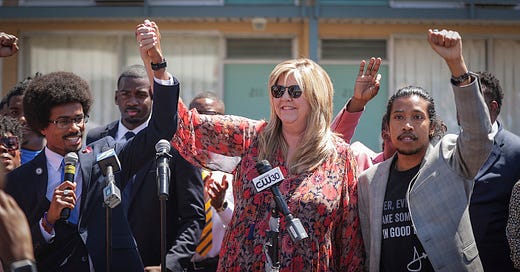Generational Change, the Democratic Party, and the 2024 Election as a Way of Bridging the Gap
2024 can still be a bridge election by propelling more, newer, different voices into the various levels of government with President Biden still on the ballot.
We’ve all heard it: President Biden is supposedly too old to be president. And sure, we should not completely dismiss those concerns either. Everyone, especially young voters like myself, has a right to voice them.
Still, I will say this: despite the “Uncle Joe” stereotype, President Biden and his Administration have accomplished a lot so far. The Biden Administration continues to make progress on the issues and they are much more willing to properly address the emerging challenges in front of us—such as the recent border surge, public safety concerns, the UAW strike, SVB, and the government shutdown. Contrast this with the Grand Obstruction Party, which gives lip service to the border and otherwise just likes to obstruct, impeach, and open baseless investigations.
Likewise, despite being in his 80s, President Biden is in relatively good physical shape. Even with a little arthritis in the legs and his stuttering, he is in much better physical and mental shape than other presidents of the modern era. Remember that FDR ran in 1944 knowing that he likely would not complete a 4th term because of his major health challenges. Remember that JFK had Addison’s disease, which notoriously weakened him physically—an interesting example of a youthful look not translating to a youthful body. Remember that Ronald Reagan faced challenges with Alzheimer’s-like dementia throughout the second half of his presidency. Let’s be thankful for the advancements in presidential care.
(And let’s not forget Trump’s questionable physical health or his clear mental instability. Why are we letting a man just three years older than Biden off the hook?).
President Biden’s decades of experience clearly offset the natural effects of aging. President Biden has proven more than capable to be on the job physically and mentally. His presidency, even with slim majorities in the House and Senate, has been effective and consequential for the future of this country. The President should be given a chance to lead once again with what we hope are more comfortable majorities. On the ballot with them should be a vast, new progressive crop of rising Democratic Party leaders who can lend needed, fresh leadership in the United States and in state legislatures all across the country.
Look no further than the Tennessee Three who exemplify the best of America amidst the worst of the America. They fundamentally changed the course of their state by exposing the levers of state government and the GOP’s attempts to create one-party systems across the South and the nation.
The time is now. The Senate is the oldest it has ever been. The House is much of the same. The wealthy fill the halls of Congress. Black women are totally left out of the Senate, and only a handful of Hispanic and Asian American officeholders represent their states as Senators. The House, meanwhile, has made much more progress on this front, but even then it still struggles to gain a more diverse membership. These patterns, far from being restricted to the federal government, apply to state governments and legislatures as well. Almost no governors are African American, and the number of Democrats from Midwestern farming and industrial communities is shrinking rapidly as well.
This is not about encouraging identity politics or mere diversity just for the sake of diversity. But we all lose when our voices are left out. When our government does not represent in any meaningful way the generational breakdown of America or its income level, we get left behind. Think of Congressman Maxwell Frost of Florida, the lone Gen Z representative who is also one of the few in Congress unable to afford renting in D.C. If other people in Congress had to deal with this problem, they may be more understanding of and proactive about addressing the crisis of affordable housing in America.
Now, think about the issues that face young people today. Voter suppression, partisan gerrymandering, youth disenfranchisement, discrimination and intimidation, income inequality, climate crises, healthcare disparities, education loss, wage stagnation, consumer risk, union busting, housing shortages, outdated infrastructure and transportation, deindustrialization, mechanization, outsourcing, etc. We need a new generation of political leadership that will have a stake in solving these issues for the long-term.
As a college student, I applaud the decision of older Democrats to hand the baton over to Leader Hakeem Jeffries, Whip Katherine Clark, and Caucus Chair Pete Aguilar. In 2024, we need another wave of rank-and-file members to build a more representative government equipped to take on all the big challenges we now face as a country.
In Maryland and Delaware respectively, we have chances to break barriers and elect two Democratic black women as U.S. Senators. We can expand the pool of Hispanics & Latinos, Asian Americans, and women in Congress. We have opportunities to elect more millennials and Gen-Zers to the House, and also leaders from many working class backgrounds. We can rebuild a formidable bench of Rural Democrats, Prairie Populists, and Midwestern progressives proud of our New Deal/Great Society ideals, and we can use the progress of Build Back Better to do so. We can once and for all abandon nonsensical, failed Reaganomics and the legacy of Clintonian neoliberalism. Like we did after Watergate and during Trump, we can usher in a new pool of leaders to Washington.
We must continue that work in state governments and state legislatures especially. A major test case for 2024 will be in the Commonwealth of Virginia, where we will fight for control of its General Assembly-along with other off-year contests in New Jersey, Pennsylvania, Kentucky, Mississippi, and Louisiana.
President Barack Obama touted change. John F. Kennedy (in spirit, at least) embodied it for his youth-centered campaign strategy in the election of 1960. This is our generation’s moment to bring back that energy—and to address child poverty, to keep our planet habitable, to protect, expand, and fund essential government services, to strengthen consumer safety and workers’ rights, to take on corporate special interests, to root out political corruption, and so much more.
What we desperately need are leaders who understand the times. Who know what it is like to have grown up in the COVID lockdowns, who have had to live with constant school shooting drills, who have had friends who are (or, for some, were) the victims of police brutality, who have been evicted from their homes, who have dealt with piling student loan debts and medical bills, and who have been evicted from their homes or unable to buy groceries.
A wave of new blood and creative ideas in government can usher in another term of monumental legislative progress. A wave of new blood can produce results, under an experienced executive leader and an astute dealmaker. This is no time to “wait your turn.”
This is no time to sit out either.
Other notes:
Condolences to Alaska Congresswoman Mary Peltola and her family on their loss of Eugene “Buzzy” Peltola-who was also a highly distinguished public servant.
My brother has a new blog-Salzillo’s Two Cents-for those interested.
And check out my Medium blog for some updated developments regarding local news in Rhode Island.





